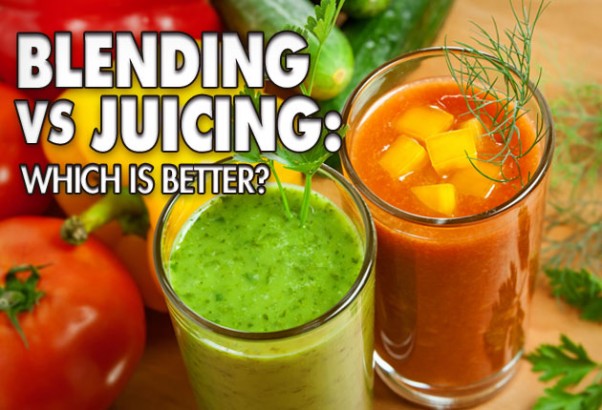It's the classic, plant-based health question — which is better, blending or juicing? The answer... both. Both blended smoothies and freshly extracted vegetable juices offer exponentially better nutrient absorption than whole, raw foods. But they are definitely not the same thing. And don't let an infomercial tell you otherwise! Although some people refer to high-powered blenders as “juicers", blenders retain the fiber, whereas juicers are specially designed to separate the fiber, leaving only a liquid packed with nutrients. The difference is, when the juice is separated from the pulp, you can easily consume a much larger volume of vegetables than you could by drinking a smoothie containing pulp. For example, if you blend a smoothie, you might include up to 7 leaves of kale along with some fruit. Those 7 leaves of kale will yield only about 1.5 oz of juice. Since we can easily drink an 8 oz serving of juice without fiber, the volume of concentrated nutrients available in 8 oz of vegetable juice would be much greater than a large smoothie containing just 1.5 oz of juice. Drinking fresh, fiber-free juice (particularly on an empty stomach) eliminates strain on the digestive tract because the juicer has already done most of the digestion work for you, having separated the fiber from the juice. Without fiber to digest, the juice can be efficiently shuttled into your bloodstream within 30 minutes. The beauty of this efficiency is that the nutrients have practically no time to degrade. The best vitamin and mineral complement to a whole food diet is plenty of freshly extracted vegetable juice. Although juicing is great for delivering concentrated nutrients to the cellular level, it does not replace need for salads and smoothies. A well-rounded diet of whole foods packed with fiber is still foundational to a healthy diet. Smoothies, blended soups, and blended salads are excellent ways to get a variety of raw, whole foods with fiber into your daily routine. Because they are filling and substantial due to their fiber content, they help curb the temptation to eat too much cooked food. And contrary to what some would say, enzyme action is not necessarily better in juice than a smoothie — we have proof! Hallelujah Acres Research Director Dr. Michael Donaldson compared the enzyme content of freshly extracted juice to the enzyme content in a smoothie. Why the debate? Some say that the heat and air involved in whipping up a smoothie degrades the enzymes. But Dr. Donaldson found the opposite to be true! "The blender did not cause any loss of enzymatic activity," he said after comparing the two. "In fact, there was a slight increase in enzymatic activity in the blender. This may be due to the blender releasing more enzymes from inside of the cells because it chops vegetable cells much finer than can be accomplished by the grinding action of a juicer." How's that for a surprise ending! Again, if we consume blended foods at meal times and fiber-free juices on an empty stomach, we are receiving the best of both worlds.
Do you prefer juices or smoothies? Scroll below the related articles to comment!







